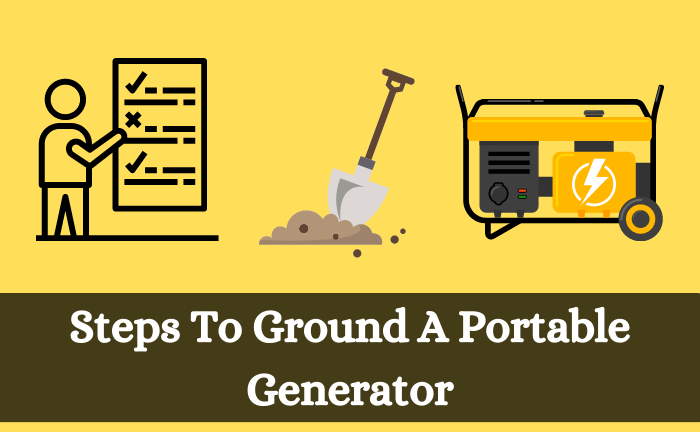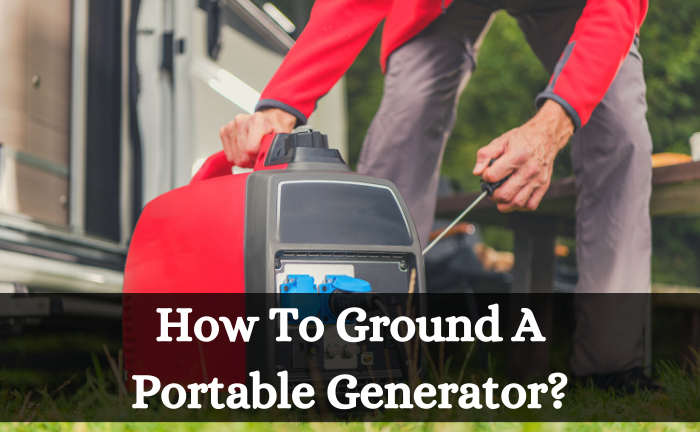A portable generator is one good way to supply continuous power at home or work. In the times of power off, portable generators proved to be very useful. It supplies enough power to make sure your work remains uninterrupted. Similarly, portable generators to apply power tools at work. Whatever the reason, portable generators are best.
Generators are grounded to avoid explosions to keep your power supply durable and safe. If you’ve recently installed a portable generator and are looking to ground it yourself, you’re at the right place. In this article, we will guide you in a hassle-free way to ground a portable generator.
Let us help you with all the tools you require while grounding the generator.
Table of Contents
Tools Required For Grounding A Portable Generator

Grounding a portable generator requires several specific tools to do the job correctly. Since you’re doing it yourself, you need the following tools for grounding. Make sure you don’t miss any of them.
- Grounding Rod
- Grounding Wire
- Wire Strippers
- Pliers
- Wrench
- Hammer
Grounding Rod
The first thing you need to have is a grounding rod. A grounding rod is a basic tool for the whole process, and it is important to pick the right one. Different grounding rods are available according to your portable generator. So the first thing is to figure out the type of your generator. Check out the user’s manual to see what grounding rod is required.
However, you must ensure that you have at least 4 feet long copper rod to connect with your generator. Although there are different sizes, a 4 feet rod is the ideal among them. It keeps your connection durable and safe.
Grounding Wire
You next require plenty of grounding copper wire for a stable connection. The quantity depends on how far you are grounding your generator. Yet, ensure you have some extra quantity in hand for connecting the rod.
Wire Stripper
A good pair of wire strippers is as important as the grounding rod. While completing the action, a set of good wire strippers is needed to strip the wire for connecting purposes. You can easily strip off the wire cover as much as you want for a good connection.
Although you can also use a knife, wire strippers are quicker and safer. So make sure you count it in.
Pliers
Here comes a stage where you need to wind the copper wire on the rod, and a good plier comes into play. Winding must be done correctly to create a stable and durable connection. So make sure you have pliers in your kit.
Wrench
Having a wrench will allow you to attach wires to the generator easily. Similarly, you would require a wrench for losing bolts for connections.
Hammer
Grounding the rod would require a hammer, so make sure you have a robust hammer or mallet to do it properly. However, ensure not to damage the copper’s coating; otherwise, there could be a terrible connection.
Related: What Size Of Generator For House?
Steps To Ground A Portable Generator

Once you have the tools mentioned above, it’s time to begin grounding. The grounding process is technical and requires great attention, so make sure you don’t skip any of the following steps. And by the end of this guide, you’ll be able to carry out the work on your own, saving you a lot of money.
So let’s get straight into it.
We’ve created the process into 3 steps as follows.
Step-1 Put Copper Rod
First, mark the spot where you want to place the rod. Use a hammer to start digging the rod into the ground at least 4 feet. Make sure the spot chosen is ideal for the grounding generator. On a lighter note, if you feel the ground is a bit hard and requires extra effort to place inside, pour some water on the ground to soften it. Spread excessive water all over and let it soak for a while.
Once you find the ground easy to dig, place the rod and start pushing it down with the hammer. Make sure you don’t damage the coating.
Step-2 Strip The Wires And Connect It
The next step after placing the rod 4 feet deeper is to connect the wires. Before connecting, you must strip the wires off using a stripper. After stripping off the wire ends, wrap it around the rod and connect it to your portable generator. Ensure to wind the wire properly for a durable connection (use a wrench for a better wrap).
Step-3 Grounding Generator
Here we have the next and final step― grounding your generator. After your copper wire has been stripped and connected to the grounding rod, it must be done.
Verify that the copper wire on the opposite side has been sufficiently stripped down to allow for connection. Then, locate a grounding bolt, which ought to be on your generator, and unfasten it. You want it to be just slightly loose enough to wrap the bolt in a stripped wire.
Afterward, you must round the region around the bolt with the stripped wire. The bolt should then be retightened. After doing that, your connection ought to be secure.
What Happens if a Generator Isn’t Grounded?
You might be wondering what would happen if you didn’t ground your generator. Well, grounding a generator might cost you some time and effort, but it eliminates the bigger risk you could face otherwise.
Using an ungrounded generator is equal to grabbing a naked wire. It could create a risk of electrocution that could hurt you physically and financially.
Similarly, your home appliances could be destroyed due to a high voltage spike that couldn’t be controlled unless you’ve grounded the generator properly.
How To Identify If A Portable Generator Should Be Grounded Or Not?
You can inspect that by checking the owner’s manual. If you don’t have it, check the construction design. Your generator’s components are made up of an independently derived system if the transfer switch on the generator provides you the choice to transfer current to a neutral ground wire. As a result, you will need to ground your rod to connect your generator.
Can I Ground A Portable Generator To A Camper?
You must ground your portable generator if you’re camping in an RV or trailer and using it to power your RV’s appliances. Connecting the ground terminal of your generator to the metal frame of your RV is the ideal approach to ground it.
Can White Wire Be Used For Grounding?
It is suggested to only use copper wire for grounding purposes. Copper wires are durable and safer than others. Contrary to this, white and gray wires can only be used for neutral conductors.
How To Know If Ground Wire Is Bad?
A bad wire shows certain signs like a failure of ignition coil, failure of sensors, or faulty fuel pump.
Related: 11 Best Generators For Home – Our Top Pick?
Wrapping Up
Grounding a portable generator is another step to enhancing its longevity and adopting safety measures. It might take a little effort, but it is worth it in the long term.
The guide as mentioned earlier is quick, and you can do it yourself easily, so I hope you’re all set to begin grounding your generator.
Hope this article will prove helpful to you.

